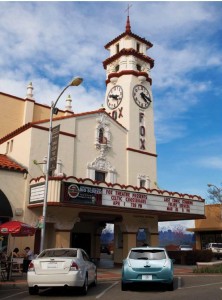New regional electric vehicle charging plans contain many of the same key recommendations, along with unique components reflecting regional characteristics. Two distinct regions that offer insightful plug-in electric vehicle (PEV) plans include the San Francisco Bay Area Air Quality Management District (BAAQMD) and the San Joaquin Valley Air Pollution Control District (SJVAPCD). While San Francisco is the state and national per capita leader in PEV adoption with 37% of California registered PEVs, the San Joaquin Valley, with 1% of California registered PEVs, is in the beginning phase of expanding its PEV infrastructure. The San Joaquin Valley has simultaneously been making strides in PEV adoption, particularly since fall 2012. Despite their differences, both the San Francisco Bay Area and San Joaquin Valley regions offer useful regional PEV plans with best practices for nationwide PEV adoption.
Nissan Leaf charging at Visalia’s Fox Theater. Source: Center for Sustainable Energy, 2013.
As of late 2013, the SJVAPCD’s jurisdiction had only a limited number of Level 2 charging stations, mostly located in the eight towns of Modesto, Stockton, Tracy, Lodi, Fresno, Clovis, Visalia, and Bakersfield, and no direct current (DC) fast charge stations. PEV ownership is concentrated in these eight towns. Considering the geographic extent of the San Joaquin Valley, one of the most apparent barriers to PEV adoption is a lack of infrastructure to support PEV charging and use. Fortunately, as Phase I of its PEV Readiness Plan notes, the SJVAPCD began studying best infrastructure siting and deployment in 2014. Other central recommendations identified to increase PEV adoption in the San Joaquin Valley include creating zoning, signage and parking policies, updating building codes, providing incentives for education of maintenance personnel, increasing resources available to municipal planning agencies that often have limited staff to update zoning codes, communicating to businesses and residents about the benefits of PEV adoption, and using the San Joaquin Valley Plug-in Electric Vehicle Coordinating Council to direct regional implementation of state and national best practices. More general guidelines that apply to most regions considering PEV implementation plans include encouraging workplace and multi-unit dwelling charging, managing grid impacts by working with utilities to encourage charging during off-peak hours, increasing public agencies’ PEV fleets, and charging infrastructure on public property.
The BAAQMD PEV Readiness Plan reflects the extensive infrastructure already in place around the San Francisco Bay Area. In juxtaposition with the San Joaquin Valley plan, it offers an example for PEV planning after adoption has become more widespread. Like the SJVAPCD plan, the BAAQMD plan highlights a need for continued education and outreach to familiarize the local community with PEVs; increasing collaboration between local groups, public agencies and private businesses in deploying PEV infrastructure; offering incentives including a vehicle buyback program to increase PEV ownership among lower income households and increase fleet adoption; continued expansion of charging infrastructure; refined permitting and building codes; refined zoning and parking codes; education of maintenance personnel and other stakeholders; and decreased utility grid impacts by communicating with local utilities.
Thought they are in very different stages of PEV adoption and infrastructure deployment, both the SJVAPCD and BAAQMD regions offer PEV implementation plans that comprehensively address the regions’ present needs and position them to confront the broader challenges to increasing PEV adoption. By including both regionally specific and broad PEV deployment challenges, the San Joaquin and San Francisco PEV readiness plans offer insight on best practices for PEV implementation planning nationwide.

